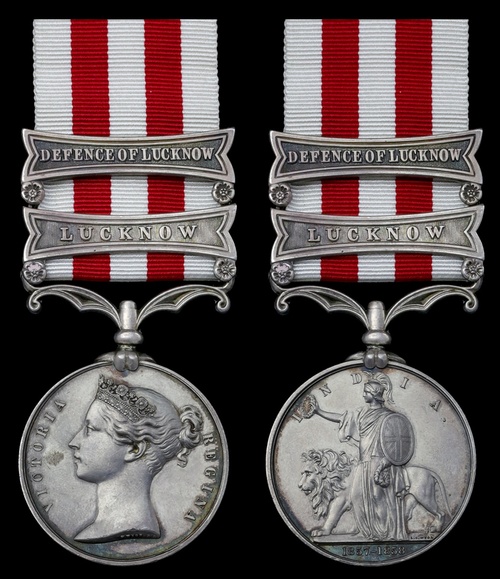
Auction: 19003 - Orders, Decorations and Medals
Lot: 24
The Indian Mutiny Medal awarded to Colour-Sergeant I. W. Love, 5th Foot (Northumberland Fusiliers), who took part in the heaviest fighting of the First Relief of Lucknow
Indian Mutiny 1857-59, 2 clasps, Defence of Lucknow, Lucknow (Cr. Sergt. I. Love, 1st Batn. 5th Fusrs.), good very fine
Note that the Medal Roll gives 'W' as Love's second initial.
Isiah William Love was baptised at St. John de Sepulchre Church, Norwich in 1827. A 15 year old boy of this name appears in the 1841 census, his occupation listed as 'silk weaver'. He lived in Newton St. Faith, Norfolk with his mother and father (also a silk weaver) and several siblings. When the Indian Mutiny began he was stationed on Mauritius as a Colour-Sergeant with the 1st Battalion, 5th Foot (Northumberland Fusiliers). The 5th sailed for China aboard H.M.S. Simoon on 19 June 1857, to participate in the Second Opium War, but upon reaching Singapore they heard of the Mutiny and were diverted to Calcutta, arriving there on 4 July. Sailing up the Ganges aboard the river steamer Benares, they engaged the Dinapore mutineers on 20 August. The Medal Roll confirms that Love was present at this action. The 5th Fusiliers then joined Sir Henry Havelock's column in early September. This combined force, numbering some 3,000 men, would attempt to relieve the British garrison of Lucknow, besieged by over 15,000 mutineers. Havelock's column crossed the Ganges on 18 September and met fierce opposition throughout the march. Entering Lucknow on 25 September, the 5th Fusiliers charged against rebel-occupied houses and entrenchments in their desperation to reach the Residency. Francis Collins, an Assistant Surgeon in the regiment, described the action in his diary (see Lot 141, April 2018):
'About a hundred yards further was a looped house inside a low walled garden, the wall was also loop-holed from which they kept up a sharp fire of musketry. The men fired a volley against the walls with the forlorn hope that some stray bullet might enter the loopholes and kill the cowards sheltered behind. We lost that day 600 killed and wounded and 48 officers.'
Havelock's men burst into the Residency compound to fervent cheers from its long-suffering British defenders. Maria Germon, an officer's wife who been trapped in the Residency since 30 June, described it as: 'The most exciting scene I ever witnessed… in an instant our whole compound was filled with them.' After such crippling losses, however, the combined force was too weak to break out. Havelock's men had brought no provisions, and this put further strain on the garrison's dwindling food supplies. The Residency was not evacuated until Sir Colin Campbell's 'Second Relief' in November. Colour-Sergeant Love took part in the actions before Lucknow in January-March 1858. The Medal Roll records that he died of cholera on 2 June 1859, and was buried at Allahabad the next day; sold with copied Medal Roll and burial register.
Recommended reading:
Germon, M., Journal of the Siege of Lucknow, ed. M. Edwards (London, 1958).
Subject to 20% VAT on Buyer’s Premium. For more information please view Terms and Conditions for Buyers.
Sold for
£900
Starting price
£550




